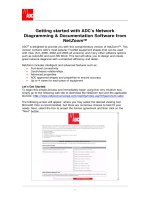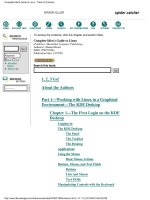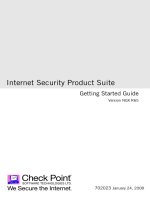Newbie’s Getting Started Guide to Linux
Bạn đang xem bản rút gọn của tài liệu. Xem và tải ngay bản đầy đủ của tài liệu tại đây (2.1 MB, 39 trang )
Newbie’s Getting
Started Guide to Linux
By Stefan Neagu
Edited by Justin Pot
This manual is the intellectual property of
MakeUseOf. It must only be published in its
original form. Using parts or republishing altered
parts of this guide is prohibited without permission
from MakeUseOf.com
Think you’ve got what it takes to write a manual
for MakeUseOf.com? We’re always willing to
hear a pitch! Send your ideas to
; you might earn up to
$400.
Table of Contents
Clossary
Introduction to Linux, FLOSS and the GPF License
Choosing the Distribution
Introduction to the Ubuntu Desktop
Where are my Applications?
Basic Commands for the Terminal
Linux Comes With Your New Computer
Further Reading
Conclusion
MakeUseOf
Glossary
You might encounter a lot of gibberish further on in
the guide, words you’ve probably never heard of
in your life. To lend you a helping hand, we’ve
spelled out some of the most prominent ones, and
their meanings.
Kernel - the core functionality of an operating
system, it translates commands from other software
directly to the hardware interfaces.
Distributions - operating systems based on the
Linux kernel.
CLI/Terminal - stands for Command Line
Interface, a method of interaction with the
computer based on text commands entered at the
prompt.
GUI - stands for Graphical User Interface, a
method of interaction with the computer that makes
use of visual representations of elements: files,
folders and actions. It is the standard environment
for modern consumer oriented operating systems.
Introduction to Linux, FLOSS
and the GPL license
Many people believe that learning Linux is hard,
that only system administrators can use it and
dismiss the idea from the very beginning. Others
would continue in their search only to find bits of
information scattered all around the internet –
without the cohesion necessary for that knowledge
to become useful; sometimes the information is
written for experienced users, leaving those who
don’t know what CLI is, in the dark. This guide’s
goal is to bring the essentials of Linux together,
helping less savvy Windows users migrate easily.
If you’re new to Linux you might make a common
mistake and assume that it is an operating system.
Well, that’s not true. Instead, when you say Linux,
you refer to any of the operating systems that are
based on the Linux kernel, like Fedora, Ubuntu or
openSuSE.
The kernel, some say the most important aspect
about an operating system, is the mediator between
the hardware and the other software applications
that may run on it, the lowest abstraction layer.
What’s different about the Linux kernel? Like most
of the applications that run on top of it, it is
actively maintained by the Free/Libre/Open Source
Software community, which is also known as
FLOSS. FLOSS software comes completely free of
charge and everyone is entitled to look at the
source code and modify it as he pleases. This
means that skilled developers from around the
world contribute their work either for free, or via
sponsorships from companies like Canonical or
IBM. But you can improve the software as well.
Microsoft’s Windows source code is not available
to anyone but Microsoft employees, and it
constitutes a felony to decompile or reverse
engineer it. You can’t build your own Windows
kernel, fix bugs, or distribute an improved version
of Windows that you created.
“The word "free" in our name does not refer to
price; it refers to freedom. First, the freedom to
copy a program and redistribute it to your
neighbors, so that they can use it as well as you.
Second, the freedom to change a program, so
that you can control it instead of it controlling
you; for this, the source code must be made
available to you.” –Free Software Definition by
Richard Stallman
There are many reasons why Linux is better, and
discussing them is beyond the scope of this guide.
Nonetheless it’s good to know that Linux is
inherently secure, portable and doesn’t need to
reboot as often as Windows.
The GNU General Public License makes this all
possible. This license provides the legal grounds
for your rights to the software. Originally written
by Richard Stallman, it ensures that even when a
work is modified or enhanced, it still remains in
the public domain for other people to use and
enjoy. It’s the most widely used license in the
FLOSS community.
Choosing the Distribution
Most Linux distributions come with a so-called
‘base system’ that comprises most of the
applications the typical computer user would need.
These distributions are usually popular and are
updated constantly with new drivers and
applications. Ubuntu, Fedora, SuSE , by far the
most popular Linux systems, are generally
considered to be easy to use for a newbie, although
they still have the power tools that advanced users
are accustomed to.
Another important aspect about switching to Linux
is hardware compatibility. While most hardware is
supported by default in most Linux distributions,
less popular or quirky hardware might not work.
For example, my ENE integrated card reader
won’t work with Ubuntu, and I still haven’t found a
solution for that. Most of the times, even if your
device isn’t supported by default you will be able
to follow tutorials posted online that guide you
through installing an unsupported driver or
patching the kernel .
There are many Linux distributions available, and
each one is a bit different. Choosing the one that’s
right for you might seem difficult at first, but it’s
actually a problem you want to have. Each of the
distributions is fine-tuned to serve a different
niche. This way you can install an operating system
that was built for multimedia creation or one that
was created for computers with low hardware
specifications.
I invite you to go to distrowatch.com. On the right
side you’ll notice there’s a Top 100 list of the most
popular distributions. Read through the description
and the reviews of the top 10 on the list. Because
this is probably your first contact with Linux, we’ll
assume that you want to install Ubuntu.
Getting Ubuntu
Getting a Linux distribution isn’t what it used to
be. Nowadays, almost everyone is on a high-
speed internet connection, and mirror servers that
contain the ISO images are online around the
world. Make sure however to choose the right
architecture; i386 for older 32-bit processors and
amd64 for newer 64-bit processors like the AMD
Turion 64. If you are in doubt, the i386 version
will work on newer processors as well as on the
old ones, but you will lose the >4GB memory
addressing support.
To download Ubuntu, click here.
In addition to downloading, there are many
companies that will mail you a CD or DVD for a
small fee. Two examples of such companies are
OSdisc.com and LinuxCD.org. Ubuntu ShipIt will
send a CD with the latest version of the operating
system for free, but it may take up to ten weeks to
arrive. All you have to do is create an account on
shipit.ubuntu.com.
Writing Ubuntu to a CD
1. Download and install Infra Recorder, a free and
open source image burning program.
2. Insert a blank CD in the drive. Cancel the
autorun dialog which pops up.
3. Open Infra Recorder and click the 'Write Image'
button in the main screen.
4. Alternatively you can select the 'Actions' menu,
then 'Burn image'.
5. Select the Ubuntu CD image file you want to
use, then click 'Open'.
6. Click 'OK'.
Installation Types
Since the Ubuntu CD is a “Live CD”, you can boot
from it and select “Try Ubuntu Without Making
Any Changes To My PC”. Ubuntu will start and
will look and react as if it were installed on your
PC. This way, you can comfortable with it before
installing.
There are four ways you can install Ubuntu:
1. Erase your hard drive and install Ubuntu as the
primary operating system. You need to backup all
your data in order to restore it later, after Ubuntu is
installed. This is the method we use in this ebook.
2. Use Wubi to easily install Ubuntu in a dual boot
configuration: both Ubuntu and Windows installed
on the same computer. Wubi doesn’t modify the
partitions of your PC and takes the guesswork out
of installing Ubuntu. Wubi keeps all its files in a
single folder and can be uninstalled just like any
other Windows application. More information
about Wubi can be found at wubi-installer.org .
Essentially, Wubi is a shortcut for inexperienced
users that allows them to enjoy the full blown
Ubuntu installation without the headache of booting
from a CD and running the installation script in an
unfamiliar environment.
3. If you’re not afraid of getting your hands a bit
dirty, you can build your own dual boot
installation. A very detailed and easy to follow
guide is available from Ubuntu’s Community
Documentation. This method let’s you fine tune
some settings.
4. Using a virtualization program. Because you’re
practically running two operating systems at the
same time, performance will be affected. You need
at least 1 GB of RAM to attempt this method.
Virtualization software, when referring to
operating systems, hides the physical
characteristics of computing platform from the
software being virtualized. For example, Ubuntu
running inside VMware on a Windows Vista PC.
The two operating systems are running
simultaneously. More information is available on
Wikipedia.
Installation Instructions
These instructions are also available as a high
quality video on YouTube.
1. Insert the Ubuntu disc into your CD drive.
2. Start or restart your computer. The Language
screen appears.
3. Select your desired language and press Enter.
The startup window appears.
4. Select Install Ubuntu and press Enter. The
Welcome window appears.
5. Choose your preferred language. Click Forward.
6. From the Selected city box, choose your closest
location. Click Forward.
7. Select your keyboard layout. To test if you have
chosen the correct layout, enter characters in the
text box. Click Forward. The Prepare disk space
window appears.
8. If you want to install Ubuntu over your entire
hard drive, then Select Guided – use entire disk
and select the hard drive that you want to install
Ubuntu. Installing Ubuntu on your entire hard disk
will erase all data that is currently on the drive. If
you want to install Ubuntu on a single partition
Dual Booting, Select Guided – resize. In the New
partition size area, drag the area between the two
partitions to create your desired partition sizes.
Click 'Forward. The “Who are you?” window
appears.
9. The next window will ask you some simple
questions, like your name, a password, a name for
the computer.
10. If you are the only user and wish to avoid the
login screen, check Log in automatically
(optional).
11. Click Forward. The Ready to install window
appears.
12. Verify that the language, layout, location, and
personal information are correct and click Install.
The installation wizard begins.
13. When the installation wizard finishes, the
installation complete window appears. Click
Restart now to restart your computer. Ubuntu is
now installed.
Introduction to the Ubuntu
Desktop
The Ubuntu desktop is designed to be user friendly
and intuitive. At the top left corner you have:
• Applications: Lists all the installed applications
divided by category.
• Places: Lists hardware connected to you
computer such as hard drives and network shares.
• System: Contains graphical tools to change the
settings for the system. It is divided in Preferences,
settings that don’t require administrator or root
privileges and Administration.
On the top right corner, you have the power button,
time, sound and network status icons. Right
clicking on the network icon will reveal more
details about available network connections.
At the bottom, the Task Switcher lists all open
windows, just like the Windows task bar. On the
left you have the “Show Desktop” button and on
the right you have “Desktop Switcher” – which
works like a second monitor, and the trashcan.
Just like on Windows, you can create folders by
Right-Click>New Folder, and perform the same
file operations. The equivalent to Explorer in
Ubuntu is Nautilus, which you can access via
Places>Any hard drive or folder.
About the Graphical User Interface
(GUI): Gnome, KDE, XFCE
The Graphical User Interface is a program that
creates visual representations of the data and
actions. In a nutshell, it’s a program that draws
windows, folders, menus and the Start button.
Using a graphical user interface is considered
more accessible to people without the necessary
know-how. For example, in order to copy a file to
your USB stick, you only need to drag and drop it
with the mouse. With the CLI, you need to
remember the full path to the file, the destination
and the “cp” command arguments.
If you look at the above screenshot of my Ubuntu
desktop, you’d be tempted to say that it is Mac OS
X. It’s not, and it took me about 15 minutes to set it
up.
The Linux graphical user interface has come a long
way in the last 7 years. It used to be extremely
simple, with only the most basic functions
available. If you wanted to configure anything
except the for wallpaper, you had to open a
Terminal and lookup in the manual the command
you needed to use. The manual is actually stored
on the computer, so it wasn’t inconvenient for
more experienced users, but Windows users were
appalled. The syntax for a lookup in the manual is:
man [-] [-k keywords] topic. But you won’t need
that if you’re using any modern Linux distribution.
Windows and Mac OS X have something in
common: one desktop GUI. Mac OS X doesn’t
even have multiple themes. Linux on the other
hand, has 3 major desktop managers and more than
10 window managers. Gnome, the most popular
and well regarded of the three, comes with your
Ubuntu installation.
The GNOME project provides two things: The
GNOME desktop environment, an intuitive and
attractive desktop for users, and the GNOME
development platform, an extensive framework
for building applications that integrate into the
rest of the desktop.
KDE, an alternative to Gnome, is in many ways
different. Without getting into a discussion about
underlying developer frameworks (Gnome is
based only on free technologies), I personally think









